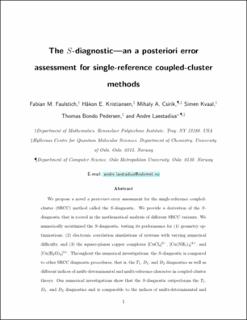| dc.contributor.author | Faulstich, Fabian M. | |
| dc.contributor.author | Kristiansen, Håkon Emil | |
| dc.contributor.author | Csirik, Mihaly Andras | |
| dc.contributor.author | Kvaal, Simen | |
| dc.contributor.author | Pedersen, Thomas Bondo | |
| dc.contributor.author | Laestadius, Andre | |
| dc.date.accessioned | 2023-10-02T06:26:37Z | |
| dc.date.available | 2023-10-02T06:26:37Z | |
| dc.date.created | 2023-10-01T13:46:03Z | |
| dc.date.issued | 2023 | |
| dc.identifier.issn | 1089-5639 | |
| dc.identifier.uri | https://hdl.handle.net/11250/3093352 | |
| dc.description.abstract | We propose a novel a posteriori error assessment for the single-reference coupled-cluster (SRCC) method called the S-diagnostic. We provide a derivation of the S-diagnostic that is rooted in the mathematical analysis of different SRCC variants. We numerically scrutinized the S-diagnostic, testing its performance for (1) geometry optimizations, (2) electronic correlation simulations of systems with varying numerical difficulty, and (3) the square-planar copper complexes [CuCl4]2-, [Cu(NH3)4]2+, and [Cu(H2O)4]2+. Throughout the numerical investigations, the S-diagnostic is compared to other SRCC diagnostic procedures, that is, the T1, D1, and D2 diagnostics as well as different indices of multi-determinantal and multi-reference character in coupled-cluster theory. Our numerical investigations show that the S-diagnostic outperforms the T1, D1, and D2 diagnostics and is comparable to the indices of multi-determinantal and multi-reference character in coupled-cluster theory in their individual fields of applicability. The experiments investigating the performance of the S-diagnostic for geometry optimizations using SRCC reveal that the S-diagnostic correlates well with different error measures at a high level of statistical relevance. The experiments investigating the performance of the S-diagnostic for electronic correlation simulations show that the S-diagnostic correctly predicts strong multi-reference regimes. The S-diagnostic moreover correctly detects the successful SRCC computations for [CuCl4]2-, [Cu(NH3)4]2+, and [Cu(H2O)4]2+, which have been known to be misdiagnosed by T1 and D1 diagnostics in the past. This shows that the S-diagnostic is a promising candidate for an a posteriori diagnostic for SRCC calculations. | en_US |
| dc.language.iso | eng | en_US |
| dc.rights | Creative Commons Attribution-NonCommercial 4.0 International | |
| dc.rights.uri | https://creativecommons.org/licenses/by-nc/4.0/ | |
| dc.title | The S-diagnostic - an a posteriori error assessment for single-reference coupled-cluster methods | en_US |
| dc.type | Peer reviewed | en_US |
| dc.type | Journal article | en_US |
| dc.description.version | acceptedVersion | en_US |
| cristin.ispublished | false | |
| cristin.fulltext | postprint | |
| cristin.qualitycode | 1 | |
| dc.identifier.doi | https://doi.org/10.1021/acs.jpca.3c01575 | |
| dc.identifier.cristin | 2180676 | |
| dc.source.journal | Journal of Physical Chemistry A | en_US |
| dc.relation.project | Norges forskningsråd: 287906 | en_US |
| dc.relation.project | Norges forskningsråd: 262695 | en_US |
| dc.relation.project | ERC-European Research Council: 101041487 | en_US |
| dc.relation.project | Sigma2: NN4654K | en_US |

